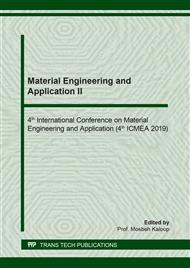[1]
S.J. Kalita, A. Bhardwaj, H.A. Bhatt. Nanocrystalline calcium phosphate ceramics in biomedical engineering. Mater. Sci. Eng. C. 27 (2007) 441-449.
DOI: 10.1016/j.msec.2006.05.018
Google Scholar
[2]
R. Murugan, S. Ramakrishna. Development of nanocomposites for bone grafting. Comp. Sci. Technol. 65 (2005) 2385-2406.
Google Scholar
[3]
G. Gergely, F.C. Sahin, G. Göller, O. Yücel, C. Balázsi. Microstructural and mechanical investigation of hydroxyapatite–zirconia nanocomposites prepared by spark plasma sintering. J. Euro.Ceram. Soc. 33 (2013) 2313-2319.
DOI: 10.1016/j.jeurceramsoc.2013.01.027
Google Scholar
[4]
A.H. Karin. Bone repair in the twenty-first century: biology, chemistry or engineering. Phil. Trans. R. Soc. Lond. A. 362 (2004) 2821–2850.
Google Scholar
[5]
J. Song. Y. Liu. Y. Zhang. L. Jiao. Mechanical properties of hydroxyapatite ceramics sintered from powders with different morphologies. Mater. Sci. Eng. A. 528 (2011) 5421-5427.
DOI: 10.1016/j.msea.2011.03.078
Google Scholar
[6]
S. Ramesh. C.Y. Tan. I. Sopyan, M. Hamdi. W.D. Teng. Consolidation of nanocrystalline hydroxyapatite powder. Sci. Technol. Adv. Mater. 8 (2007) 124-130.
DOI: 10.1016/j.stam.2006.11.002
Google Scholar
[7]
M.A. Lopes. F.J. Monterio. J.D. Santos. Glass–reinforced hydroxyapatite composites (fracture tougthness and hardness dependence on microstrutural characteristics). Biomaterials. 20 (1999) 2085–(2090).
DOI: 10.1016/s0142-9612(99)00112-x
Google Scholar
[8]
W. Suchanek. M. Yashima. M. Kakihana M. Yashimura. Hydroxyapatite/hydroxyapatite‐whisker composites without sintering additives: Mechanical properties and microstructural evolution. J. Amer. Ceram. Soc. 80 (1997) 2805–2813.
DOI: 10.1111/j.1151-2916.1997.tb03197.x
Google Scholar
[9]
F.N. Oktar. G. Goller. Sintering effects on mechanical properties of glass-reinforced hydroxyapatite composites. Ceram Int. 28 (2002) 617-621.
DOI: 10.1016/s0272-8842(02)00017-2
Google Scholar
[10]
S.J. Kalita. S. Bose. H.L. Hosick. A. Bandyopadhyay. CaO – P2O5 –Na2O-based sintering additives for hydroxyapatita ( HAp) ceramics. Biomaterials. 25 (2004) 2331-2339.
DOI: 10.1016/j.biomaterials.2003.09.012
Google Scholar
[11]
J.C. Knowles. W. Bonfield. Development of a glass reinforced hydroxyapatite with enhanced mechanical properties. The effect of glass composition on mechanical properties and its relationship to phase changes. J. Biomed. Mater. Res. 27 (1993) 1591–1598.
DOI: 10.1002/jbm.820271217
Google Scholar
[12]
E. Bouyer. M. Gitzhofer. M.I. Boulos. Morphological study of hydroxyapatite nanocrystal suspension. J. Mater. Sci, Mater. Med. 11(8) (2000) 523-531.
Google Scholar
[13]
R.E. Riman. W.L. Suchanek. K. Byrappa. C. Chun-Wie. P. Shuk. C.S. Oakes. Solution synthesis of hydroxyapatite designer particulates. Solid. State. Ionics. 151 (2002) 393-402.
DOI: 10.1016/s0167-2738(02)00545-3
Google Scholar
[14]
M.A. Meyers, A. Mishra. D.J. Benson. Mechanical properties of nanocrystalline materials. Progress. In. Mater. Sci. 51 (2006) 427-556.
DOI: 10.1016/j.pmatsci.2005.08.003
Google Scholar
[15]
G. Dewith. H.H.M. Wagemans. Ball-on-ring test revisited. J. Amer. Ceram. Soc. 72(8) (1989) 1538-1541.
Google Scholar
[16]
J.A. Juhasza. S.M. Besta. R. Brooksb. M. Kawashitac. N. Miyatac. T. Kokuboc. T. Nakamurad. W. Bonfielda. Mechanical properties of glass-ceramic A-W-polyethylenecomposites: effect of filler content and particle size. Biomaterials. 25 (2004) 949–955.
DOI: 10.1016/j.biomaterials.2003.07.005
Google Scholar
[17]
S.J. Kalita. A. Bhardwa. H.A Bhatt. Mater. Nanocrystalline calcium phosphate ceramics in biomedical engineering. Sci. Eng. C. 27(3) (2007) 441-449.
DOI: 10.1016/j.msec.2006.05.018
Google Scholar


